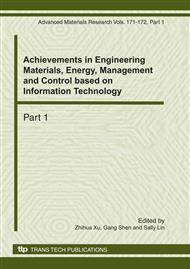[1]
Bai H. Approach of some problems in elastic structure vibration control. Beijing: Peking university, (1995).
Google Scholar
[2]
Housner G W. Structural control: past, present, and future. EngMech, (1997), 9.
Google Scholar
[3]
Guan Xin Chun. Magnetorheological fluid damping control structure and its smart drive theoretical and experimental study. Harbin Institute of Technology Ph.D. thesis, (2000), 5.
Google Scholar
[4]
Qu J T, Li H N. Progress on Study of Energy Dissipation for Passive Response Control. Thesecond international forum on advances in structural engineering, (2008) Oct, Dalian, China.
Google Scholar
[5]
Housner G W, Soong T T. Second generation of active structural control in civil engineering. Microcomputers in Civil Engineering, (1996), 111.
DOI: 10.1111/j.1467-8667.1996.tb00443.x
Google Scholar
[6]
Tirca L D, Foti D, Diaferio M. Response of middle-rise steel frames with and without passive dampers to near field ground motions. Engineering Structures, (2003), 25(2).
DOI: 10.1016/s0141-0296(02)00132-3
Google Scholar
[7]
Hong-Nan Li, Gang Li. Experimental study of structure with"dual functions" metallic damper. Engineering Sturctures, (2007), 29(8).
Google Scholar
[8]
Toshiyuki Sueoka, Shingo Torii, Yasuhiro Tsuneki. The application of response control design using middle-story isolation system to high-rise building. The 13th World Conference on Earthquake Engineering, Vancouer, Canada. (2004).
Google Scholar
[9]
Ashour S A, Hanson R D. Elastic seismic response of buildings with supplemental damping. Report №. UMCE 87-01, Department of Civil Engineering, University of Michigan. AnnArbor, MI, (1987).
Google Scholar


